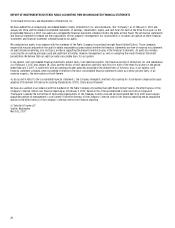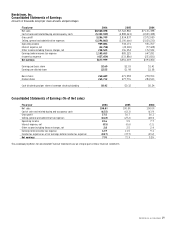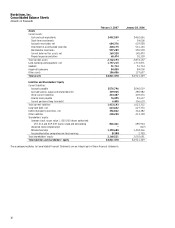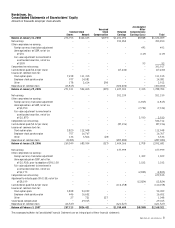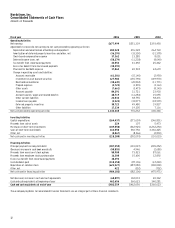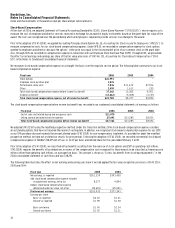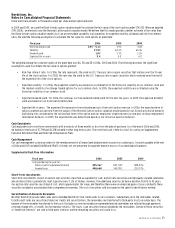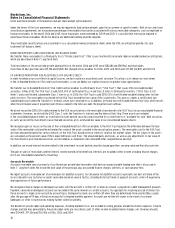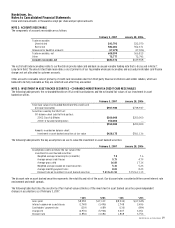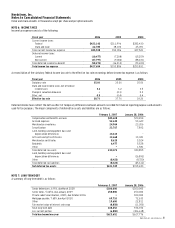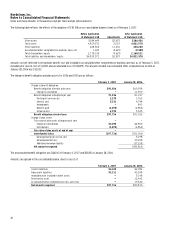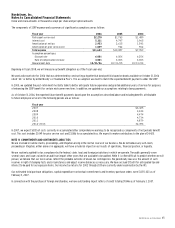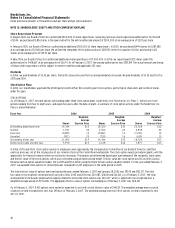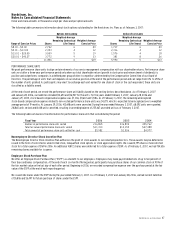Nordstrom 2006 Annual Report Download - page 56
Download and view the complete annual report
Please find page 56 of the 2006 Nordstrom annual report below. You can navigate through the pages in the report by either clicking on the pages listed below, or by using the keyword search tool below to find specific information within the annual report.
38
Nordstrom, Inc.
Notes to Consolidated Financial Statements
Dollar and share amounts in thousands except per share and per option amounts
Loyalty Program
Customers who reach a cumulative purchase threshold when using our Nordstrom private label cards or our co-branded Nordstrom VISA credit cards
receive merchandise certificates. These merchandise certificates can be redeemed in our stores similar to gift certificates. We estimate the net cost
of the merchandise certificates that will be earned and redeemed and record this cost as the merchandise certificates are earned. The cost of the
loyalty program is not significant in relation to the corresponding sales, so the program expense is recorded in cost of sales rather than as a reduction
of net sales.
Vendor Allowances
We receive allowances from merchandise vendors for purchase price adjustments, cooperative advertising programs, cosmetic selling expenses,
and vendor sponsored contests. Purchase price adjustments are recorded as a reduction of cost of sales at the point they have been earned and the
related merchandise has been sold. Allowances for cooperative advertising and promotion programs and vendor sponsored contests are recorded in
cost of sales and selling, general and administrative expenses as a reduction to the related cost when incurred. Allowances for cosmetic selling
expenses are recorded in selling, general and administrative expenses as a reduction to the related cost when incurred. Any allowances in excess of
actual costs incurred that are recorded in selling, general and administrative expenses are recorded as a reduction to cost of sales. The following table
shows vendor allowances earned during the year:
Fiscal year
2006
2005
2004
Purchase price adjustments
$70,365
$58,103
$47,707
Cosmetic selling expenses
120,560
107,166
96,936
Cooperative advertising and promotion
66,984
57,575
57,786
Vendor sponsored contests
3,018
3,668
3,975
Total vendor allowances
$260,927
$226,512
$206,404
Allowances were recorded in our consolidated statement of earnings as follows:
Fiscal year
2006
2005
2004
Cost of sales
$137,563
$118,104
$106,902
Selling, general and administrative expenses
123,364
108,408
99,502
Total vendor allowances
$260,927
$226,512
$206,404
Fair Value of Financial Instruments
The carrying amounts of cash equivalents and short term-investments approximate fair value. See Note 7: Long-term Debt for the fair values of our
long-term debt and interest rate swap agreements.
Derivatives Policy
We periodically enter into foreign currency purchase orders denominated in Euros for apparel, accessories and shoes. We use forward contracts to
hedge against fluctuations in foreign currency prices. These forward contracts do not qualify for derivative hedge accounting. At the end of 2006 and
2005, the notional amounts of our foreign currency forward contracts at the contract rates were $10,220 and $6,127. We also use derivative financial
instruments to manage our interest rate risks. See Note 7 for a further description of our interest rate swaps.
Recent Accounting Pronouncements
In July 2006, the FASB issued Interpretation No. 48,
Accounting for Uncertainty in Income Taxes
(“FIN 48”), which requires that the tax effects of a
position be recognized only if it is more likely than not to be sustained on audit, based on the technical merits of the position. FIN 48 also provides
guidance on derecognition of income tax assets and liabilities, classification of current and deferred income tax assets and liabilities, accounting for
interest and penalties associated with tax positions, accounting for income taxes in interim periods, and income tax disclosures. The provisions of FIN
48 are effective for us as of the beginning of our 2007 fiscal year. We will adopt FIN 48 in the first quarter of 2007, as required. We continue to
evaluate the impact of adoption, but expect that it will not be material.
In September 2006, the FASB issued Statement No. 157,
Fair Value Measurements
(“SFAS 157”). SFAS 157 defines fair value, establishes a framework
for measuring fair value, and expands disclosures about fair value measurements. SFAS 157 is effective for fiscal years beginning after November 15,
2007. We are assessing the potential financial statement impact of SFAS 157.
In February 2007, the FASB issued Statement of Financial Accounting Standards No. 159,
The Fair Value Option for Financial Assets and Financial
Liabilities
(“SFAS 159”). SFAS 159 permits entities to choose to measure many financial instruments and certain other items at fair value. SFAS 159
will be effective at the beginning of fiscal 2008. We are presently evaluating the impact of the adoption of SFAS 159 on our results of operations and
financial position.


